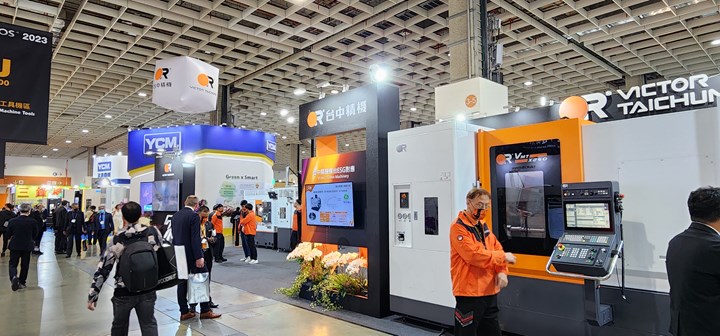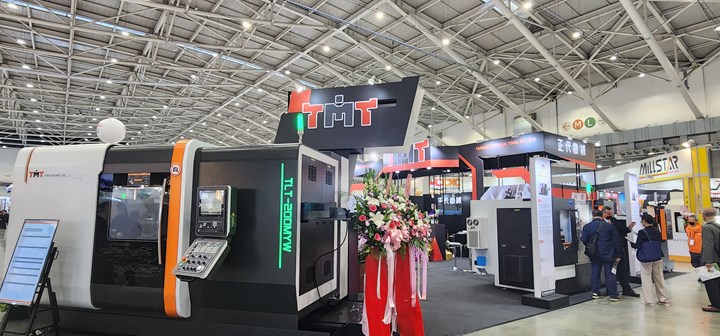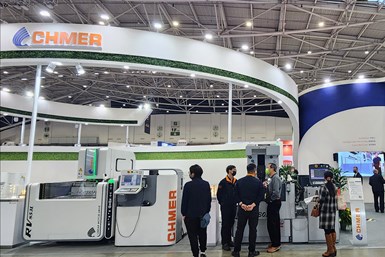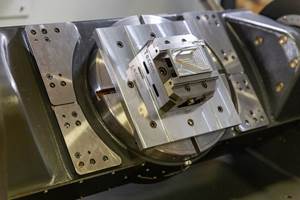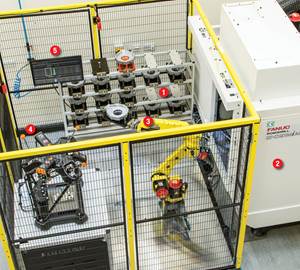Share




At TIMTOS 2023, digital manufacturing tools were at the forefront of many companies’ booth exhibits.
Taiwan has made international news lately for its role as the world’s largest supplier of semiconductors, dwarfing its nearest competitor in both volume and quality. Supporting this industry, which relies on extremely precise processes, is a robust machine tool industry that supplies everything from five-axis machining centers to precise grinding machines and EDMs.
Recently, I traveled to the country’s capital Taipei for the Taipei International Machine Tool Show (TIMTOS), co-hosted by the Taiwan Association of Machinery Industry (TAMI) and the Taiwan External Trade Development Council (TAITRA), and I found a machine tool industry that is keeping pace with the latest manufacturing innovations.
Digital Tools
Many companies focused on the benefits of digital tools for machining parts. For example, Fair Friend Group (FFG) Sales Director Andy Hung explored the numerous monitoring systems the company uses for its rotary transfer machines. “Our visualizer system has real-time monitoring of machining operations,” Hung says. “In the same program, we have maintenance suggestions. Both are easily understood by the operator, who can easily see when actions need to be taken.”
Victor Taichung Machinery manufactures milling machines (including five-axis VMCs), multitasking machines and lathes. The company’s machines use digital twins to accurately model the cutting conditions inside the work area.
Wayne Hsueh, sales director at Victor Taichung Machinery, spoke about the applications of digital twins in manufacturing. “The digital twin sets up a 3D model through servo parameters to simulate the actual cutting conditions of a machine tool to guarantee parts can be machined perfectly as expected and without losses,” Hsueh says. Toolpath simulation using a digital twin not only enables machinists to prevent collisions, but provides them the opportunity to identify ways to improve the machining process and reduce cycle times.
According to Buffalo Machinery General Manager Paul Chang, the benefits of digital technology are many and varied. “Industry 4.0 means you will be able to do much better job training and strategizing,” Chang says.
Additionally, he notes that digital toolsets included with the company’s machines enable shops to monitor energy consumption, both to meet carbon management goals and reduce cost. “We monitor the energy consumption of the machine tool, and this enables us to modify processes to meet carbon goals and reduce energy costs.” These capabilites come standard with many of the company’s machine tools, including the company’s gantry-type five-axis VMCs like the Axile G6.
While these digital tools have widespread utility, one area that saw an especially intense use of digital solutions was the realm of automation.
Intelligent Automation
Automation was obviously one of the more important technologies on display at TIMTOS, but companies emphasized more than just bar feeders and robots. Instead, the focus was on intelligent automation — the use of sensors and other digital tools that enable machine cells to adapt to changing parameters. This approach to automation is designed to provide flexibility to the user.
According to Dah Lih Machinery Sales Manager Ricard Wang, “The premise of smart automation is that mechanical equipment must have intelligent capabilities so that it can have intelligent functions such as fault prediction, precision compensation and automatic parameter setting.” For example, his company’s Tool Breakage Monitor tracks the spindle motor for changes in the current load. When the load is abnormal, it automatically stops machining and sounds an alarm.
This kind of system can help avoid scrapped parts during lights-out machining, in addition to making it easier for one operator to serve multiple machines during their shift.
At the Taiwan Machine Tool booth, the company showed off its TLT-200MYW, which can combine milling, drilling, turning and grinding in one machine. The variety of processes makes single-setup processing much more attainable.
Yeong-Chin Machinery (YCM) highlighted its multi-pallet system, a pallet pool that enables users to load up to eight different workpieces. “If you put eight different parts on this system,” says YCM Director Jeffery Ervay, “you can run eight different part programs, and you can run them in any order.”
This makes it perfect for automating high-mix, low-volume work. Moreover, these systems connect to machines with monitoring capabilities that enable users to identify problems in-process. “We can see how long machines are running or identify which parts might potentially be going bad,” says Ervay.
Buffalo Machinery’s Paul Chang further discussed the use of machine tool monitoring in unattended machining. “For example, in an overnight shift, nobody will be at the machines, but you can monitor them from your device to make sure they are still making money for you.” When problems arise, managers can react immediately or prepare the morning shift for disruptions to production. These monitoring features come standard on many Buffalo machines.
At the Taiwan Machine Tool booth, Executive Vice President Clair Chen introduced me to the company’s TLT-200MYW, a multitasking machine capable of milling, drilling, tapping, turning and grinding in a single setup. “With this machine, you can reduce errors from loading and unloading,” Chen says. The machine comes with monitoring software and tool managements systems that enables managers to keep track of spindle utilization and tool wear, even remotely. “With smart automation, the customer can not only overcome labor shortages, but also create a more efficient production line.”
The image of automation as a single cell devoted to manufacturing a single part year-round has fallen by the wayside as flexible solutions like cobots and pallet pools have made automated machining more accessible to job shops. With digital tools like the ones on display at TIMTOS, automation is even more accessible and more reliable than it has been in the past.
Two Markets, Both Alike in Dignity
One thing that stood out in my conversations with Taiwanese manufacturers was the fundamental similarity in the needs of Taiwanese and American machine shops. Both are facing harsh personnel crunches that are being addressed through increased automation. Both rely on the defense industry for a great deal of their work. Both produce large numbers of precision parts with tolerances measured in microns.
At the Chmer booth, the company showcased the improvements made to its EDM lineup. Its i8+ power supply, for example, has reduced power consumption rates by 20%, according to the company.
These similarities mean that the Taiwanese machine tool market fills many of the needs that American manufacturers face: low personnel, complex parts, difficult materials and fragile workpieces are all common in Taiwanese machine shops. With such similar challenges, many U.S. machine tool manufacturers can comfortably look at solutions developed in Taiwan to overcome the challenges they face.
This brings us back to widespread presence of digital tools at the show. For decades, shops have been told that a digital revolution is coming to the machining world. That’s no longer the case — the digital revolution has already arrived, and OEMs around the world are fully embracing digital solutions that have proven reliable in actual manufacturing environments.
Machine monitoring, toolpath simulation, digital twins, tool monitoring — these have all proven their value in many shops and can help the U.S. meet challenges as it expands domestic manufacturing.
Related Content
Protecting Your Automation Investments
Shops need to look at their people, processes and technology to get the most of out their automation systems.
Read MoreDiving Deeper Into Machine Monitoring Data
Data visualization is the first step in using machine monitoring data, but taking it to the next level requires looking for trends within the data.
Read MoreProcess Control — Leveraging Machine Shop Connectivity in Real Time
Renishaw Central, the company’s new end-to-end process control software, offers a new methodology for producing families of parts through actionable data.
Read More5 Stages of a Closed-Loop CNC Machining Cell
Controlling variability in a closed-loop manufacturing process requires inspection data collected before, during and immediately after machining — and a means to act on that data in real time. Here’s one system that accomplishes this.
Read MoreRead Next
Registration Now Open for the Precision Machining Technology Show (PMTS) 2025
The precision machining industry’s premier event returns to Cleveland, OH, April 1-3.
Read More5 Rules of Thumb for Buying CNC Machine Tools
Use these tips to carefully plan your machine tool purchases and to avoid regretting your decision later.
Read MoreSetting Up the Building Blocks for a Digital Factory
Woodward Inc. spent over a year developing an API to connect machines to its digital factory. Caron Engineering’s MiConnect has cut most of this process while also granting the shop greater access to machine information.
Read More


















